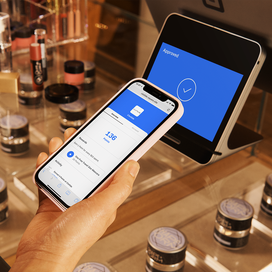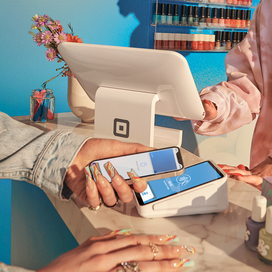Table of contents
As a business owner, you’re always looking for ways to streamline operations and improve the customer experience. If you run a busy restaurant or retail store, a self-service kiosk may help you do just that.
What is a self-service kiosk?
A self-service kiosk, also called a self-service point of sale (POS) system, is an interactive touchscreen device that allows customers to buy products or services without staff assistance. It includes hardware and software components that make it possible for customers to browse items, place orders, and pay independently.
The hardware component of a self-service kiosk is a screen device fixed in place to surfaces such as walls, countertops, or floor stands. The software component is a kiosk application that allows you to design an ordering workflow that suits your business.
How does a self-service kiosk work?
A self-serve kiosk is an interactive terminal that allows customers to independently browse, customize, and complete transactions using a touchscreen interface. Powered by intuitive software, the kiosk displays menus or options, responding to touch for seamless navigation. Customers can select items, adjust preferences (like size or toppings) and proceed to payment through an integrated system like a card reader, NFC (for mobile payments), or cash acceptor.
Once the self-service POS system has confirmed payment, the kiosk processes the order, often sending it to a backend system (like a kitchen or inventory database), and provides a digital or printed receipt. The entire journey — from selection to completion — is designed for speed, convenience, and minimal staff assistance, enhancing efficiency for both customers and businesses.
How to use a self-service kiosk
To use a self-serve kiosk, a customer simply taps the touchscreen to begin and then follows the prompts to complete their task, whether it’s placing an order, checking out items, or accessing information. Common use cases for self-service kiosks include:
- Ordering food (customizing meals, adding special requests)
- Self-checkout (scanning items, applying discounts, paying)
- Product lookup (checking prices, specs, or inventory)
- Ticketing and check-in (booking flights, printing boarding passes)
An array of industries use self-serve kiosks:
- Restaurants (fast food, cafes)
- Retail stores (supermarkets, clothing shops)
- Health and beauty (salons, fitness studios)
- Transportation (airports, train stations)
- Healthcare (hospital check-ins, pharmacy pickups)
The process for using a self-service kiosk is quick, contactless, and user-friendly.
What are the benefits of a self-service kiosk?
Improve space management
A self-service kiosk can save significant counter space. Square Kiosk, for example, can be fixed on walls, counters, or floor stands, so you can customize the device to fit your space without making any major structural changes to your restaurant or store. To guide the traffic flow towards your self-service kiosk, consider placing ‘Order Here’ signage nearby.
Free up staff time
Customers can complete orders with little or no staff attention on a self-service kiosk. This helps free up staff members for other important activities that benefit from human interaction. According to the Square Future of Restaurants report, 75% of restaurant owners believe that AI and automation will improve key areas, such as inventory management, payments, and marketing. While more than 25% of diners reported preferring not to use any form of automation at restaurants, 74% indicated they were open to automation where restaurants are short-staffed.
Onboarding a self-service kiosk may be particularly helpful if your business has a low headcount or, like many restaurants, is experiencing higher labor costs due to rising minimum wage requirements.
Give customers more control and a better customer experience
Self-service kiosks give customers greater privacy and control by allowing them to browse menus, customize orders, and pay without staff interaction, which is ideal for those who prefer a more independent dining experience. Orders process instantly, reducing human errors and speeding up service, while built-in upselling features let customers explore add-ons at their own pace.
In self-service mode, customers have complete control over their orders, so they can select items they need quickly and check out faster. For busy restaurants with loud atmospheres, this can translate to fewer order errors and shorter wait times, which helps improve the customer experience overall.
“We operate in small, loud spaces — with busy indoor restaurant locations and food trucks. Square Kiosk improves our order accuracy by avoiding misheard orders when diners self-order from our menu,” Danielle Murcia, chief operating officer at Crepes Bonaparte told Square.
With no need to wait in line or rely on busy staff, transactions become faster and more convenient, leading to a smoother overall experience.
Increase your revenue while reducing costs
Adding a kiosk to your restaurant or storefront can also help bring in more sales. First, self-service kiosks offer customers anonymity, so customers can order more items or make special requests without feeling judged.
Second, self-service kiosks allow you to set up well-planned upsells and other incentives that can be presented to customers in a carefully considered way. Many ordering platforms, like Square Kiosk, include visual menus with upselling features that suggest additional items based on a customer’s order. This can help drive up check averages by encouraging add-ons such as sides and beverages or calling attention to bundled meals. That’s good news for restaurant owners, as research shows that customers who interact with self-service kiosks typically purchase 10-30% more than those who engage with restaurant employees.
With lower overhead and increased order accuracy, restaurants can see higher profit margins while enhancing the customer experience through convenience and faster transactions. The initial investment in self-service POS systems pays off through long-term savings and revenue growth.
Receive better customer insight
Customer activities on self-service kiosks can be tracked accurately, giving you more insight into customer behavior and preferences through top-selling items and associated revenue. This data can enable you to offer more targeted experiences.
For example, you might offer promos on the most popular menu items. Square Kiosk also integrates with Square Loyalty programs, so diners can easily enroll and accrue points with every order.
Self-service kiosk drawbacks
While self-service kiosks offer many benefits, restaurants should plan for potential challenges:
- Accessibility may also be a concern for elderly or disabled customers who struggle with touchscreens, necessitating staff assistance as a backup.
- Patron resistance from those who prefer traditional ordering, requiring clear instructions and transitional support. That’s why it’s important to have human staff on hand, available to take orders for those that prefer to face-to-face interaction.
With proper planning, including routine upkeep, inclusive design, and customer education (as well as staff support for those who prefer it), you can manage these hurdles effectively.
How much does a self-service kiosk cost?
The cost of self-serve kiosks for restaurants can vary widely based on features, hardware quality, and software complexity. Basic models start at around $1,000–$2,500 per unit, while advanced systems with large touchscreens, integrated payment processing, and custom branding can range from $3,000 to $7,000+ each.
Additional expenses may include installation, maintenance, and software licensing fees. However, many businesses see a strong return on investment through labor savings and increased sales, making self-serve kiosks a cost-effective upgrade over time. Leasing options and subscription-based software can also help reduce upfront costs.
How to set up a self-service kiosk for your business
Analyze your business needs
Consider whether a self-service kiosk is a wise investment for your business. Think about the purpose of your kiosk and how you intend to use it. For example, if you run a busy quick-service restaurant, you may want to speed up customer service or optimize space. In contrast, if you operate a full-service restaurant, you may need an easy way for servers to punch in orders without crowding the kitchen or counters.
Choose the right device
Once you’re clear about the purpose of your self-serve kiosk, the next step is to choose a device. Consider ease of use. The last thing you want is a device that’s difficult for customers to use or requires several minutes of explanation. That defeats the purpose and experience of a self-service kiosk.
The same goes for your staff. Choosing a solution that integrates directly with your POS and kitchen display system can help your team fulfill more orders quickly.
Next, match device specs against your requirements. If freeing up counter space is a key requirement, consider a compact device such as Square Kiosk, which can be fixed anywhere — on a wall, a flat surface, or a floor stand. A compact design can also give you space to add more than one kiosk to your store or restaurant to take even more orders.
Set up your kiosk
Choose a good spot in your store or restaurant. Depending on the device you choose, you may not need a technician to install it. For example, all the mounting hardware needed to install Square Kiosk is included in the box, requiring zero service visits. Plus, if you change your mind about a kiosk location, you can uninstall it and move it to another location.
While physically installing a self-service kiosk takes about an hour, the whole project, from planning and prototyping to full deployment, can take several months for large, custom solutions. The timeline depends on factors like scope, vendor selection, and whether the self-serve kiosks are off-the-shelf or custom-built.
Promote your kiosk
Your self-serve kiosk is only helpful if your customers use it. Inform customers about your kiosk and find ways to boost adoption. In-store signage can introduce customers to the kiosk and provide easy instructions. You can also encourage customers to use the kiosk by offering a discount on orders placed via the self-service kiosk.
Self-service kiosk FAQs
Are self-service kiosks replacing workers?
Self-service kiosks are not intended to eliminate jobs, but rather to shift staff toward higher-value, customer-focused tasks. In essence, self-service POS systems can offer employees an array of benefits:
- Repetitive task management, including order-taking and payments, so staff can shift to higher-value roles like customer service, food prep, and table maintenance.
- More engaging work for employees, such as resolving issues, upselling in person, and ensuring a smoother dining experience.
- Labor optimization to help manage peak hours.
- Reduced manual entry, so teams can focus on speed and quality, reducing stress and errors during rushes.
- Why would people use self-service kiosks?
Self-serve kiosks offer customers convenience, speed, and control. Many customers will use kiosks because they make ordering faster, reduce wait times, and often provide a more personalized or private experience.
What is the difference between a kiosk and a machine?
While all self-service kiosks are machines, not all machines are kiosks. Kiosks are interactive and user-facing, designed for self-service, while “machines” is a broader term that includes any mechanical or automated device, often without any user interaction.
![]()















